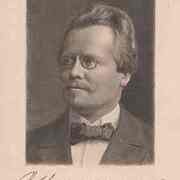Otto Julius Bierbaum (1865–1910)
Autor von Samalio Pardulus (bibliothek kubin)
Über den Autor
Bildnachweis: Photo © ÖNB/Wien
Reihen
Werke von Otto Julius Bierbaum
Eine empfindsame Reise im Automobil von Berlin nach Sorrent und zurück an den Rhein : in Briefen an Freunde… (1992) 4 Exemplare
Sonderbare Geschichten 3 Exemplare
Der neubestellte Irrgarten der Liebe : um etliche Gänge und Lauben vermehrt ; verliebte, launenhafte, moralische und… (2017) 3 Exemplare
Aus dem Irrgarten der Liebe 3 Exemplare
Gugeline. Ein Bühnenspiel in 5 Aufz. von Otto Julius Bierbaum. Mit Buchschmuck v. E. R. Weiss. Als 1.… 2 Exemplare
Briefe an Gemma 1 Exemplar
Hans Thoma 1 Exemplar
Ausgewählte Gedichte 1 Exemplar
Zur Kurzweil heitere Geschichten 1 Exemplar
Hamburger Lesehefte : Otto Julius Bierbaum : Zäpfel Kerns Abenteuer : Ein Märchen (1986) — Text — 1 Exemplar
Die drolligen Geschichten des Herrn Balzac 1 Exemplar
Biographie 1 Exemplar
Das Reimkarussell 1 Exemplar
Das höllische Automobil : Novellen 1 Exemplar
Gesammelte Werke 1 Exemplar
Zwei Münchener Faschingsspiele 1 Exemplar
Maultrommel und Flöte : neue Verse 1 Exemplar
Hans Wurst und andere Grotesken 1 Exemplar
Zwei Stilpe-Komödien 1 Exemplar
Das schöne Mädchen von Bao 1 Exemplar
Zugehörige Werke
Der Roman der Zwölf : ein literarischer Scherz aus dem Jahre 1909 (1992) — Mitwirkender — 10 Exemplare
50 seltsame Geschichten — Mitwirkender — 1 Exemplar
Velhagen und Klasings Almanach 1909 — Mitwirkender — 1 Exemplar
Getagged
Wissenswertes
- Andere Namen
- Möbius, Martin
- Geburtstag
- 1865-06-28
- Todestag
- 1910-02-01
- Geschlecht
- male
- Nationalität
- Deutschland
- Geburtsort
- Grünberg, Schlesien, Deutsches Reich
- Sterbeort
- Dresden, Sachsen, Deutschland
- Wohnorte
- Dresden, Sachsen, Deutschland
Leipzig, Sachsen, Deutschland
München, Bayern, Deutschland - Berufe
- journalist
editor
writer
librettist
Mitglieder
Diskussionen
Samalio Pardulus in The Chapel of the Abyss (Juli 2021)
Rezensionen
Dir gefällt vielleicht auch
Nahestehende Autoren
Statistikseite
- Werke
- 57
- Auch von
- 4
- Mitglieder
- 154
- Beliebtheit
- #135,795
- Bewertung
- 3.9
- Rezensionen
- 2
- ISBNs
- 28
- Sprachen
- 2
- Favoriten
- 1




Samalio Pardulus was a painter in medieval Albania. Rather than documenting him from an omniscient third-person narrator as in À rebours or through the medium of his own written journals as in Fantazius Mallare, Bierbaum places two narrative frames between the reader and the character. First, there is a "staid philistine" Italian painter Messer Giacomo, imported to instruct Samalio, whose journals form the purported documentary basis of the story in the form of extensive quotations. Then there is the anonymous archivist who introduces and comments on Giacomo's account. Through the course of the book, this archivist outside of the quotes retreats to invisibility, having left behind only a suitable readerly suspicion regarding Giacomo's perceptiveness.
Samalio himself is ugly, talented, and blasphemous. He is concerned with making objects out of his imaginings, and to the extent that this work tends to horrify his pious teacher, his explanations of it become theological, deprecating a cosmic demiurge and exalting his own "godly pleasure in the grotesque" (14). Beyond his inchoate gnosticism and solipsism, Samalio defines himself with incestuous ambitions for his beautiful sister. These eventuate in a numinous domestic apocalypse. The interrelation of the principal characters--Samalio, his sister Maria Bianca, their father the Count, an unnamed watchman, and Messer Giacomo--eventually becomes so outre that it awoke in me suspicions of allegory.
This first English edition is illustrated with many full-page charcoal drawings by Alfred Kubin that appeared in the original 1911 German edition. Some of these depict Samalio's paintings, but most are scenes from the novel.… (mehr)